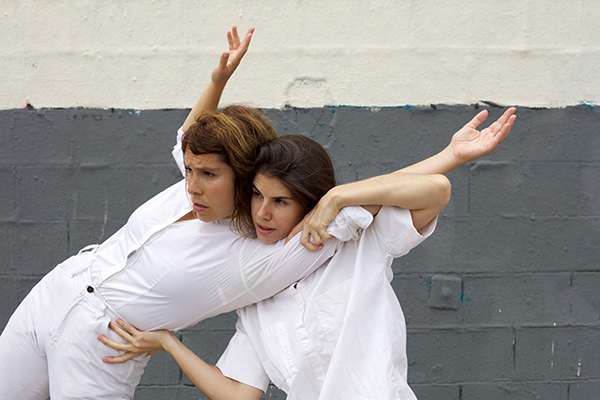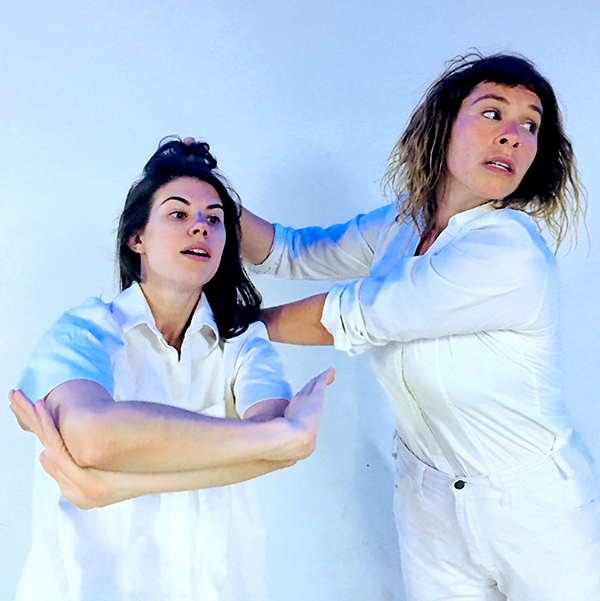Confronting White Supremacy
An Interview with Sarah Ashkin and Brittany Delany
Sarah Ashkin and Brittany Delany are using their choreographic platform, GROUND SERIES, to present task, a confrontation of white supremacy through dance performance. They discuss the impetus and importance of the work.
task premieres August 17th and 18th at Highways Performance Space in Santa Monica, California.
~~
In task, you are looking at the problematics of the white female body. Why this content and why now?
Sarah: task germinates from our separate and shared research and backgrounds into race, gender and dance studies. My recently completed graduate research marks the legacy of racism within western concert dance. My inquiries into the white dancing female body, dance training as a mechanism for white supremacy, and analysis of the theater as a white space inform my contributions to the making of task.
Brittany: Over the past two years, I have co-founded and co-led the intersectional intergenerational feminist artist collective, Wyld Womxn, based in the Coachella Valley. My work organizing womxn in communal discussions, artistic events and political protest around issues of the gaze, consent, violence, race and healing guide my need to address the historical and present day problematics of white feminists within the frame of task.
task is a response to the racist paradigm in which white choreographers can create work about poetic abstraction, formal concepts or ‘universal narratives’ while the work of choreographers of color is often solely interpreted through the lens of race, racism and the racialized dancing body. GROUND SERIES believes it is white artists’ responsibility to mark the white dancing body of the proscenium as racialized, and even as a historical and present-day vessel of racist cultural practice. Entrenched in themes of failure, listening and accountability, this duet invites the audience to consider our work in the current political moment – as artists, as cultural patrons and as people. White supremacy is a white problem.
What is your work process like? Has it been introspective (looking at your own experiences) or have you brought in outside perspectives?
In rehearsal, we walk the length of the studio discussing and prompting the problematics of our white dancing bodies throughout the space. Sometimes we experiment with the power dynamics of the space – front, back, center and sidelines – and craft movement scores to distill key relationships and choices. Other days we drag out our Beckys (our inner Beckys and also those Beckys at large) and ask her: How do you dance? What do you desire? What are you trying to escape? What does it take for you to listen? In researching and reflecting on iconic problematic white women, like Tomi Lahren and Carolyn Bryant, we develop phrase work, gestural and postural vocabulary to exaggerate and satirize these characters’ embodiments.
Some rehearsals we do not dance. Instead, we read Sara Ahmed, George Yancy, and listen to bell hooks, Audre Lorde and Claudia Rankine. These readings, reflections and discussions take place in person, on the phone and over e-mail. We attend White People for Black Lives actions and Alliance of White Anti-Racists Everywhere meetings.
The poetics of violence, womanhood, whiteness and cringe, of de- and re-humanization, cannot be illuminated in isolation. Our community has been wrapped into the process of this work offering critical feedback and invaluable perspectives. Because anti-racist work is, at its heart, community work, it has been essential to open our process.
Our team of collaborators is a group of white women artists interested in utilizing their art practice as a space for white anti-racist work. Our dramaturg Sue Roginski, our composer Carolyn Pennypacker Riggs, and our designer Zoe Koke join GROUND SERIES in taking on white supremacy as a white problem. As a team, we read, we talk, we listen, we watch, we push, we share, we question, we undo, undo, undo, redo, redo, redo, try again and try again. Each of these brilliant women has been instrumental in the making and breaking and remaking of task.
We also have had a radiant crew of women of color arts consultants provide pointed feedback and participate in development and marketing of the work. We are extremely grateful to Michelle Castillo (poet, writer, activist, founder of Wyld Womxn, founder of Lola’s Kusina pop up eatery), Kai Hazelwood (dancer, choreographer, dance teacher), and Brittany Gash (marketing and development for Invertigo Dance Theatre in LA) for their willingness to share their perspectives, responses and vision for this work. Finally, Virginia Schmitt of White People for Black Lives, an organization made up of white folks seeking to provide dynamic response to the calls to action from Black Lives Matter LA, has also offered her feedback, feelings and dreams for the making of task. Our creative team and consultants working in activist and art spaces have helped us to specify and chart the scary territory we’re stirring up.
This practice of turning in, turning out, listening in, listening to people of color, highlighting who is here, who is absent, has been a guiding practice for our dance-making. Black feminist scholar from Australia Sara Ahmed has provided the framework for this active “turning” in her essay “Declarations of Whiteness: The Non-Performativity of Anti-Racism.” She writes:
“Perhaps it’s time to ‘return’ to the ‘turn’ of whiteness studies, by asking where else we might turn. If ‘whiteness studies’ turns towards white privilege, as that which enables and endures declarations of whiteness, then this does not simply involve turning towards the white subject, which would amount to the narcissism of a perpetual return. Rather, whiteness studies should involve at least a double turn: to turn towards whiteness is to turn towards and away from those bodies who have been afforded agency and mobility by such privilege. In other words, the task for white subjects would be to stay implicated in what they critique, but in turning towards their role and responsibility in these histories of racism, as histories of this present, to turn away from themselves, and towards others. This ‘double turn’ is not sufficient, but it clears some ground, upon which the work of exposing racism might provide the conditions for another kind of work. We don’t know, as yet, what such conditions might be, or whether we are even up to the task of recognizing them.”
How does task build on previous research and experience?
In January of 2018, Wyld Womxn, the feminist creative collective in the Coachella Valley co-founded by Brittany, was invited to present public programming for the art exhibition The New Feminist Gaze at Simeon Den Gallery. At the performance night ‘Stories of Womxn,’ we debuted the beginnings of task in the dramatic alley space adjacent to the gallery. By framing our creative project on the problematics of oppressive white feminism, we responded to the evening’s curatorial question: “What is the new feminist gaze?” This first showing of task set us on our path of considering the issue of racism in dance as an issue of gender, race and cultural history.
What kind of discussion are you hoping to ignite through task? Are there certain types of audiences you particularly hope to reach, and how do you plan on reaching them?
As white women grounding our practice of taking accountability for white supremacy through dance performance, task is aimed at encouraging the white dance community to join the conversation. This approach does not exclude folks of color; it just admits where the gap is and attempts to address it head on.
Our three biggest take-aways from the research and rehearsal process that we hope to share with our audiences are 1) To take up African-American philosopher George Yancy’s call that white people tarry with the idea that white people are the problem in our racist society. To tarry, Yancy explains, is the process of holding or being with something long past the point of comfort. As artists, tarrying with racism feels like a creative life-long project. 2) To confront the realities of our white privilege which surface as dancers in the form of our training, our opportunities to perform, to feel safe and welcome in class and in the theater, and the power to assume the universal body. These privileges are not earned, rather they are a part of an invisible system ushering our white dancing bodies to “the top.” And 3) To dissect the quote from Claudia Rankine, “Because white men can’t police their imaginations, black people are dying” (Rankine, 2014). As we see it, dance training, dance performance and dance funding are all critically linked to our national cultural imagination. Dance has the ability to shape culture and, at the same time, is intrinsically shaped by culture. It is our responsibility as dancers, dance makers and dance presenters to uncover the ways in which we are complicit in white supremacist practices of privileging the white body and dismantle these practices.
Are there any themes or perspectives that have come up through your research that you don’t think fits into task but that might ignite more research or another performance in the future?
We’ve come to a point where we will never make a work in the future without considering the symbol of our white dancing bodies as inherent to the piece. No longer will our rehearsal and creative process be limited to the studio time or framed site for engagement. By incorporating numerous readings, community discussions, and participation in activist gatherings into the process, the research has become more multi-faceted and alive with access points. Expanding the ‘how’ of making dance has helped us to critique our tools and habits so we can more effectively and honestly respond to challenging research questions.
In considering a future project, we highly value the role of a dramaturg to help us shape, edit and clarify the piece. Since our past works have been largely ensemble site-specific pieces, we haven’t had the opportunity to take dance works on tour. We are excited to bring task to future audiences and stages.
Any other thoughts?
Currently, Black Lives Matter LA is engaged in an ongoing action calling for justice for LA District Attorney Jackie Lacey, who has not prosecuted a single cop for the killing of over 400 people in her five-year term. Through weekly actions, community support of families who have lost a loved one to state violence, and an unwavering commitment to justice, Black Lives Matter LA needs our political, personal and financial support. You can make a donation to one of our most important leaders fighting for all our future here.
Proceeds from task workshops and box office will go towards Black Lives Matter LA.
For more information and tickets see sarahashkin.com/task.
Works Cited:
Ahmed, S. (2004). Declarations of Whiteness: The Non-Performativity of Anti-Racism. Borderlands. 3, [online] 3(2). Available at: http://www.borderlands.net.au/vol3no2_2004/ahmed_declarations.htm [Accessed 26 Nov. 2016].
Yancy, G. (2012). Look, a white!. Philadelphia, PA: Temple University Press.
Rankine, S. (2014). Citizen: An American Lyric. Minneapolis, MN: Graywolf Press.
~~


